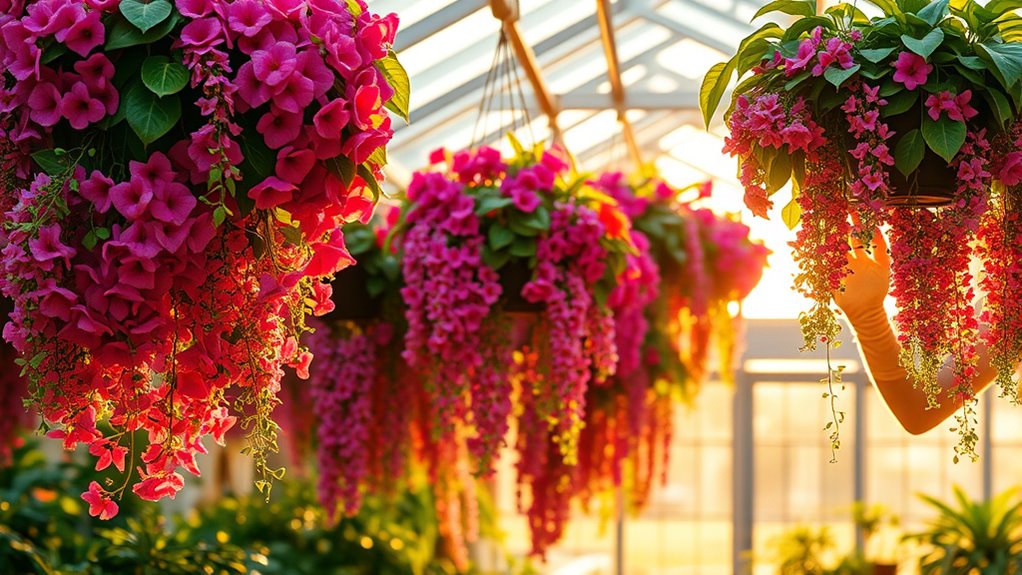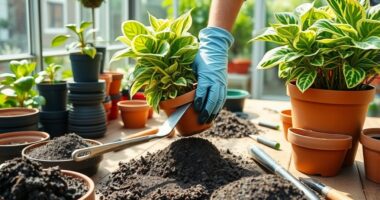To care for hanging baskets in your greenhouse, water early in the day to minimize evaporation and adjust based on temperature. Use slow-release fertilizers at planting, then switch to water-soluble types in summer. Prune regularly to promote growth and check for pests frequently. Make sure your plants get the right amount of sunlight and good air circulation. With proper care, your baskets will thrive. Keep going for more useful tips on maintaining your beautiful plants!
Key Takeaways
- Water hanging baskets early in the morning or late in the evening to minimize evaporation and maintain moisture.
- Use slow-release fertilizers at planting, then switch to water-soluble options as summer approaches for immediate nutrient uptake.
- Regularly prune overgrown limbs and deadhead spent blooms to encourage new growth and maintain shape.
- Position baskets based on sunlight needs, ensuring full sun plants receive at least six hours of direct sunlight.
- Monitor for pests using yellow sticky cards, and maintain good air circulation to prevent diseases in your greenhouse.
Watering Strategies for Optimal Growth
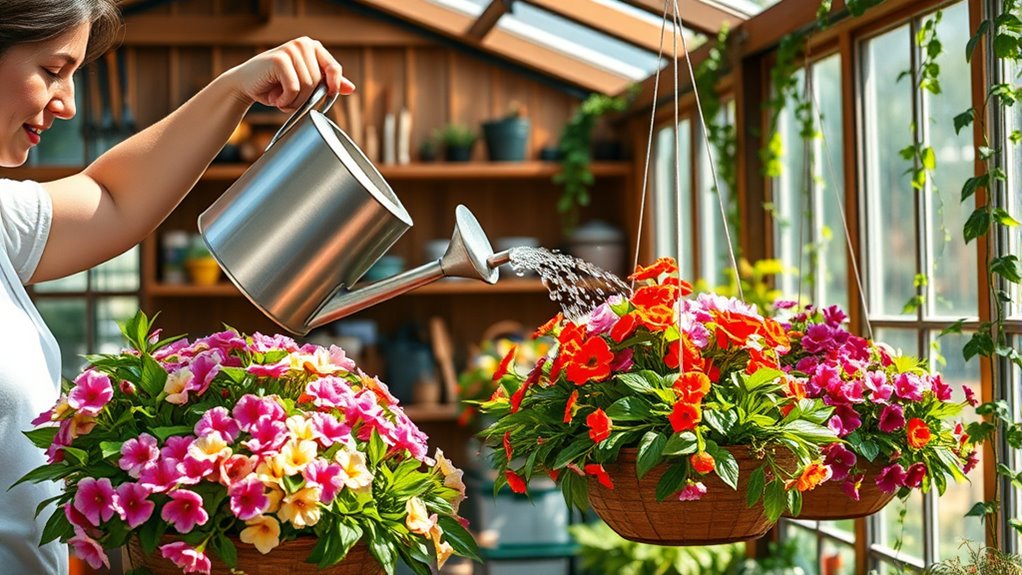
How can you guarantee your hanging baskets thrive? Start by watering them in the morning or early evening to reduce evaporation.
During hot summer months, you might need to water twice a day to keep the soil moist. For new baskets, water less initially to encourage root growth, but always verify the water drains from the bottom.
In hot summer, water twice daily for moist soil; new baskets need less water initially to promote root growth.
Use fresh potting soil with added perlite for better drainage and avoid waterlogging, which can lead to root rot.
Check your soil daily; hanging baskets dry out faster than ground plants. When watering, use a can without a rain spout for precise application and avoid watering from above to prevent leaf spotting.
Adjust your watering routine based on sun exposure and temperature fluctuations.
Fertilization Techniques for Healthy Plants
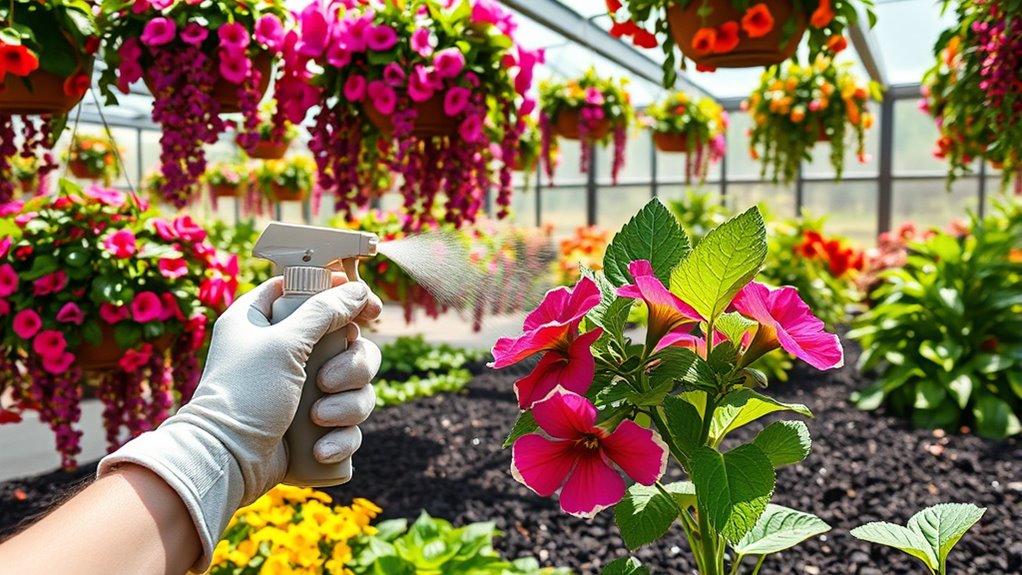
Watering is just one part of keeping your hanging baskets healthy; fertilization plays a vital role in their growth too.
Start with slow-release fertilizers at planting for a steady nutrient supply. As summer approaches, switch to water-soluble fertilizers for immediate nutrient uptake, applying them weekly during peak growth. You can alternate between fertilizers to balance nutrient needs.
Remember to fertilize in the morning and use the watering can method to avoid fertilizer burn. Watch for temperature—avoid fertilizing when it exceeds 95 degrees.
Make sure your pots have good drainage to prevent nutrient buildup and root rot. Finally, pay attention to your plants' specific nutrient requirements for ideal results. Understanding the importance of good drainage is crucial for maintaining healthy plants.
Happy growing!
Pruning and Maintenance for Blooming Beauty
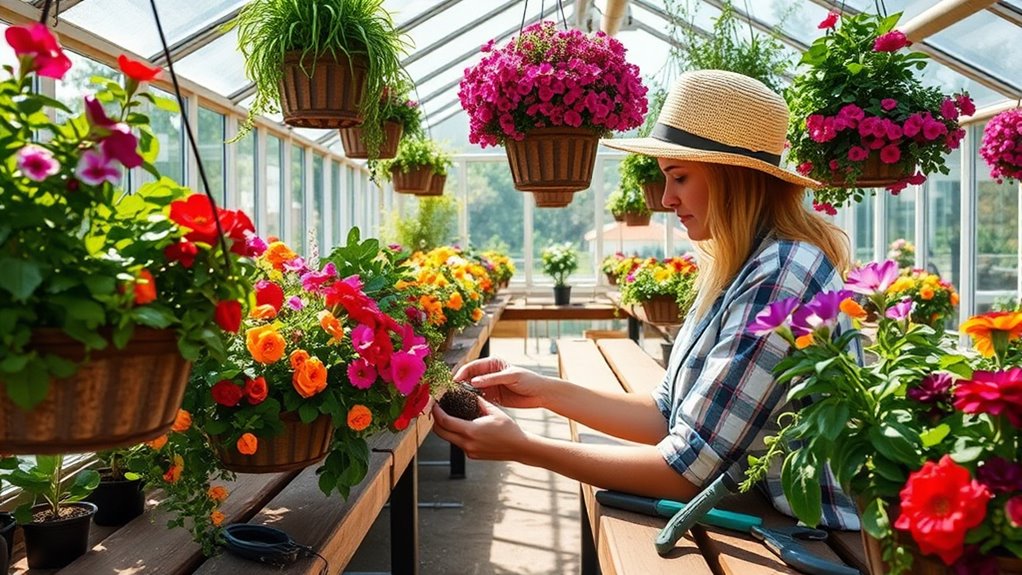
While nurturing your hanging baskets, pruning and maintenance are essential for achieving vibrant blooms and a lush appearance.
Use sharp scissors or shears to prune overgrown limbs, cutting back plants by 1/3 to 1/2 to promote fuller growth. Aim to prune once or twice a season, ideally during mid-summer, to keep your baskets symmetrical and healthy.
Regularly deadhead by pinching off spent blooms below the seed pod to encourage new flowers and guarantee your baskets stay attractive. Trim as needed to maintain a tidy look, promoting bushy growth.
Regularly inspect your baskets for pests and diseases, adjusting your maintenance schedule based on weather conditions to keep your plants thriving.
Sunlight and Location Considerations
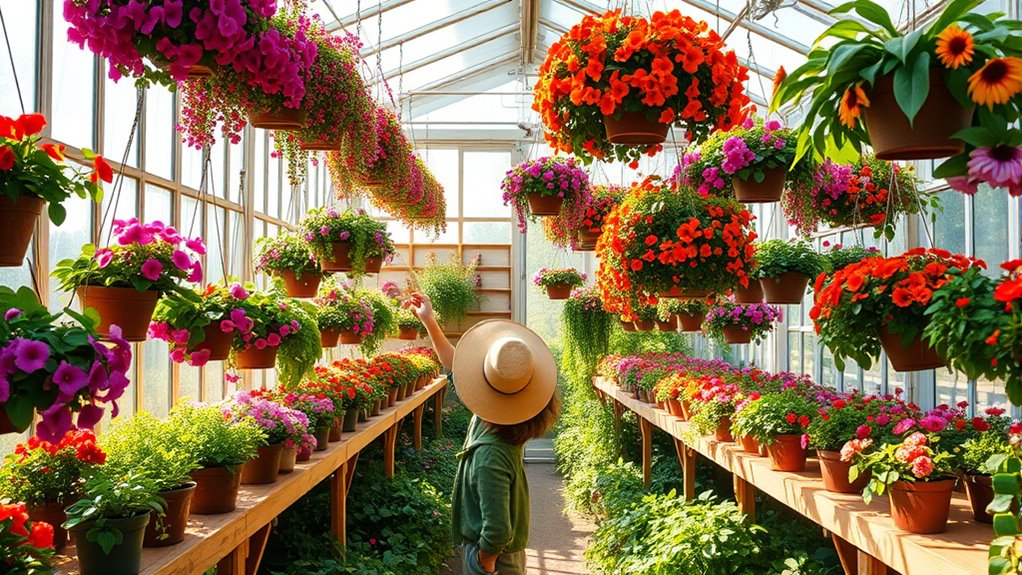
Pruning and maintenance set the stage for healthy growth, but choosing the right sunlight exposure and location for your hanging baskets is just as important.
For full sun plants like geraniums, guarantee they get at least six hours of direct sunlight. Partial sun plants, such as Torenia, thrive on four to six hours. Shade plants like Swedish Ivy need less than four hours.
Position your baskets in a north-south orientation for better light distribution, and keep in mind that hanging baskets can cast shadows affecting lower plants.
Maximize vertical space for more plants and guarantee easy access for watering and pruning. Proper placement not only optimizes light but also enhances air circulation, reducing mold risks. Additionally, ensuring plants receive proper sunlight exposure can significantly influence their overall health and growth.
Pest and Disease Management Practices

Effective pest and disease management practices are essential for keeping your hanging baskets healthy and vibrant.
Start by regularly scouting for pests, using yellow sticky cards above your plants to monitor for winged pests like thrips and whiteflies. Early detection lets you choose from a wider range of control options.
Implement good cultural practices, such as proper watering and fertilization, to maintain plant health and prevent infestations.
Utilize biological control agents for pests like spider mites, and don't hesitate to apply systemic pesticides judiciously when necessary.
Also, guarantee good air circulation and proper watering techniques to prevent diseases.
Finally, remove any diseased plants promptly to stop disease spread in your greenhouse.
Seasonal Care Tips for Hanging Baskets
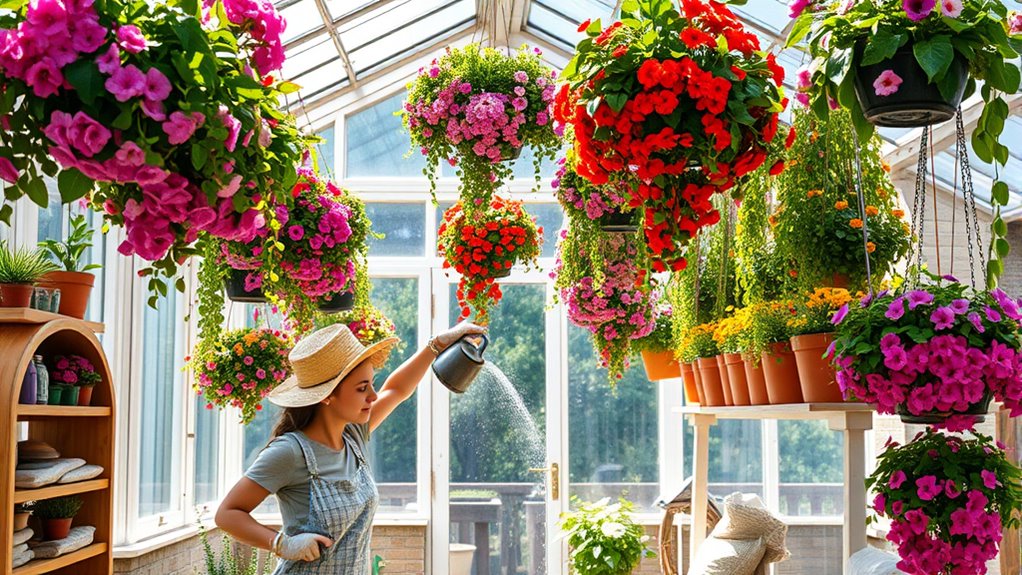
Caring for hanging baskets throughout the seasons requires attention to watering, fertilization, and maintenance.
In full sun, water your baskets every other day, and check soil moisture by inserting your finger about an inch into the soil. Water in the morning to minimize evaporation, applying enough water until it drains from the bottom.
Fertilize every couple of weeks with a balanced fertilizer like Jack's 20-20-20 to support growth.
Don't forget to deadhead and trim your plants once or twice a season to encourage bushy growth and new blooms.
Pay attention to sunlight needs, placing baskets in suitable locations, and rotating them for even light exposure.
Daily inspections will help you catch any signs of stress early.
Preparing for Travel With Your Baskets
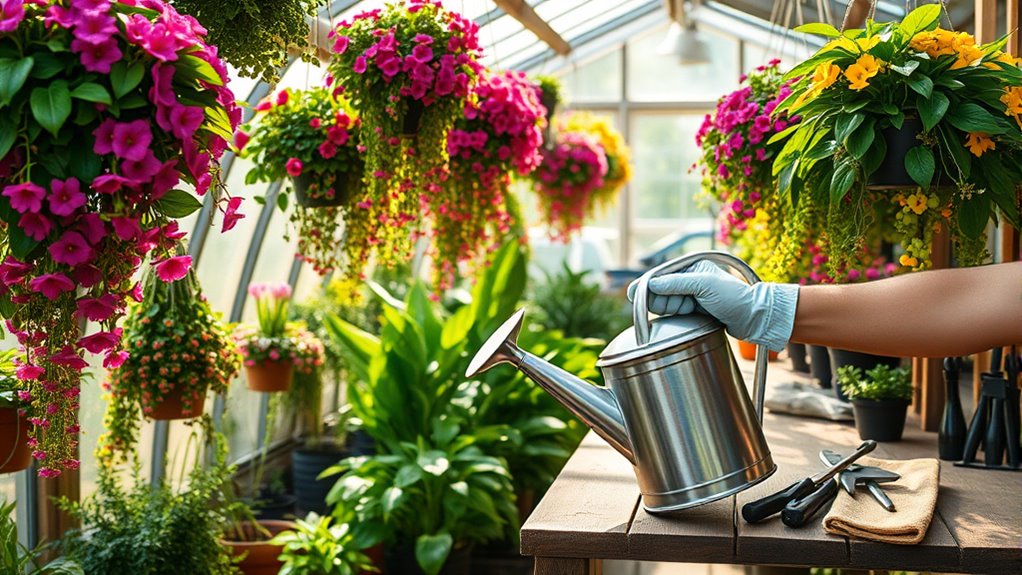
When you're planning to travel, it's essential to prepare your hanging baskets to guarantee they thrive in your absence.
Start by pruning your plants to reduce their water needs and prevent new growth. Thoroughly water them before you leave, making sure they're well-hydrated.
Skip fertilizing to slow growth and conserve water. Maintain a stable greenhouse temperature above freezing, and apply insecticidal soap to fend off pests.
Consider using automated watering systems or self-watering planters, and incorporate water-retaining materials like hydrogels.
Verify proper ventilation to avoid fungal diseases. If possible, arrange for a friend to check on your plants and leave clear instructions to guide them.
This way, your baskets will stay healthy while you're away.
Frequently Asked Questions
What Types of Plants Are Best for Hanging Baskets?
When choosing plants for hanging baskets, consider vibrant options like petunias and calibrachoa for their long bloom times.
If you want something unique, fuchsias attract hummingbirds, while nasturtiums add edible flair.
For fruits, opt for trailing cherry tomatoes or strawberries, both easy to grow.
Don't forget herbs like basil and thyme, which thrive in baskets.
Finally, add some greenery with ferns or succulents like string of pearls for texture and charm.
How Can I Create a Visually Appealing Arrangement?
Ever seen a masterpiece come to life?
To create a visually appealing arrangement, start by mixing clumpers, trailers, and foliage plants for depth. Use a checkerboard pattern to maximize coverage, placing taller plants at the center.
Layer different textures and colors while maintaining symmetry. Don't forget to leave some negative space to allow each plant to shine.
With thoughtful design, your arrangement can transform into a mesmerizing focal point that draws everyone's attention.
When Should I Replace My Hanging Basket Plants?
You should replace your hanging basket plants when they start to look leggy or decline in health.
Typically, annuals last throughout the growing season, so plan for a refresh in early spring. If you notice a drop in blooms or growth by mid-summer, consider cutting back or replacing them.
Also, after the first hard frost, it's time to swap out any sensitive plants to keep your baskets vibrant and healthy.
Can I Use Regular Garden Soil in Hanging Baskets?
You can't use regular garden soil in hanging baskets. It retains too much water, which can lead to root rot, and it's heavier, putting strain on your supports.
Instead, opt for soilless potting mixes that offer better drainage and aeration. These mixes are lighter and often come with added nutrients, ensuring your plants thrive.
Ultimately, choosing the right soil mix will help keep your hanging baskets healthy and vibrant.
What Tools Do I Need for Maintaining Hanging Baskets?
To maintain hanging baskets, you'll need several essential tools.
Start with pruning shears for trimming overgrowth and promoting healthy growth. A watering can or hose with a nozzle guarantees even watering, while garden gloves protect your hands during the process.
Consider using fertilizer spreaders and measuring cups for accurate nutrient distribution. Finally, drainage tools help prevent waterlogging, guaranteeing your plants thrive.
These tools will make your maintenance tasks efficient and effective.
Conclusion
So, you thought hanging baskets would be a low-maintenance charm? Think again! With your newfound watering, fertilization, and pest management skills, you're now the proud parent of a botanical family. Embrace the irony—what started as a simple decorative touch turned into a full-time gig! But hey, the vibrant blooms and lush greenery are totally worth the extra effort. Just remember, when you're away, your plants won't water themselves—unless you've magically trained them! Happy gardening!
